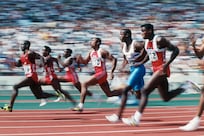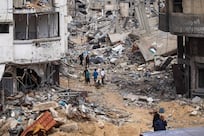The kites fluttered above plumes of black smoke from tyres burning at the fence that separates Gaza from Israeli territory.
As Israeli soldiers fired tear gas and live rounds at the Palestinians massed near the barbed wire border fence, small groups of young men stood back behind earthen mounds, adeptly pulling at long lines to manoeuvre the kites — and their tails of burning cloth — over the parched Israeli farmland beyond the fence.
Further back, others were pulling strings too.
Only a short walk from the fence, the protest organisers worked the crowd from a podium shielded from the scorching sun by a huge netted roof. Named the National Committee for the Great March of Return and Breaking the Siege, since March 30 the group has been calling on Gazans to commemorate the expulsion of Palestinians from their land in 1948. Last Friday, that theme changed to protesting the capture of Jerusalem by Israeli troops in the 1967 war.
_______________
Read more:
Israel fires warning shots to stop Gazans flying balloons, kites
Emergency Gaza UN General Assembly meeting called by Arab states
US vetoes Kuwait UN proposal to protect Palestinians
_______________
The drumbeat of those protests had begun well before the crowds gathered at five spots along the separation fence. From mid-morning, loudspeakers had blasted recorded messages from lorries driving through Gaza city.
"Now it's time to liberate Jerusalem and bring back its beauty and glory," a metallic voice echoed through streets. "The National Committee for the Great March of Return and Breaking the Siege is asking you to take part in these protests today."
Most of those who come to the fence had not been born when the Palestinians were expelled nor when the Israelis captured Jerusalem, and are instead motivated by the appalling situation in the narrow strip of land on the Mediterranean coast.
Since Hamas was elected in 2006, Israel and Egypt have enforced a blockade on Gaza that has all but collapsed the local economy.
The Israeli military has repeatedly clashed with Hamas, which it designates a terrorist organisation, and the subsequent destruction has added to the hardship endured by Gazans. The blockade also severely restricts movement out of Gaza, with the territory commonly described as an open air prison.

"We have been living under a siege for 12 years," said Mohammed Alouh, who works in the administration of Shafeay mosque in the Askula neighbourhood of Gaza City. "We've urged the world community to end the siege, but it hasn't happened, so we are going to the fence to break it ourselves."
The mosque's imam had encouraged worshippers to join the protests at the end of midday prayers, said Mr Alouh. Next to the mosque, a bus stood ready to transport those who heeded the imam's call.
The protests have become part of the Friday routine in Gaza. The weekly gatherings have galvanised residents, and proven a useful distraction to Gaza's increasingly unpopular rulers. Hamas, which has prevented elections since 2006, has a tight grip on the enclave. But its inability to improve the daily lives in Gaza has begun to undermine its position, experts say.
"There is political pressure building on Hamas," said Mkhaimar Abusada, a professor of political science at Al Azhar University in Gaza. "Two thirds of the people in Gaza consider Hamas to be a major cause of their problems."
Unemployment in Gaza stands at 44 per cent, according to the World Bank, and over 60 per cent of those under the age of 30 are unable to find work. The Palestinian Central Bureau of Statistics estimates that one third of Gaza residents live below the poverty line. Dilapidated infrastructure provides neither enough clean water nor more than four hours of electricity a day.

Hamas moved quickly to take control of the organising committee.
"The protests were started by independent activists," said Mr Abusada. "Hamas jumped in and started leading the protests."
The Great March of Return protests are the brainchild of Ahmed Abu Artema, a 33-year-old journalist and writer, whose poems are popular on social media. The political parties in Gaza, chief among them Hamas, then muscled in on the organising committee.
"We can't do anything about this, the political factions control everything in Gaza," said Mr Artema, who admitted that he is less involved in the protests than in the beginning. "We can't ignore them and we can't deny that they are part of this."
Hamas also uses its sway over Gaza's mosque to its advantage, and Shafeay mosque is not the only one where the call to prayer is followed by the call to protest.
"In Gaza most of the imams are in the pay of Hamas," said Mr Abusada.
Hamas's involvement in the protests has not gone unnoticed by the Israelis, who have tried to dissuade Gazans from demonstrating by playing on discontent with the group. Israeli aircraft dropped leaflets on to Gaza last Thursday, urging residents to refrain from protesting at the fence.
"It would be good for you not to allow Hamas to take you hostage to add to their political credit," the flyer reads.
But so far, the Israelis are losing the propaganda war.
"We are also angry at Hamas, but we can't protest against them," said Naeem Hassan Hamada, whose son Mohammed died on June 2 after being shot in the leg by an Israeli sniper during the May 14 protests. The priority must remain protesting against the Israeli occupation, he said.
Mr Hamada's 30-year-old son was heavily indebted and unemployed after a failed business venture, according to his father. Instead of turning on Hamas, he went to the fence. His father said his depression caused him to disregard the danger, and he was shot. He died of his wounds after being released early from a hospital overwhelmed with casualties.
Organisers have vowed to continue the protests.
"Hamas has succeeded by diverting the internal pressure towards the Israeli occupation," said Mr Abusada.





